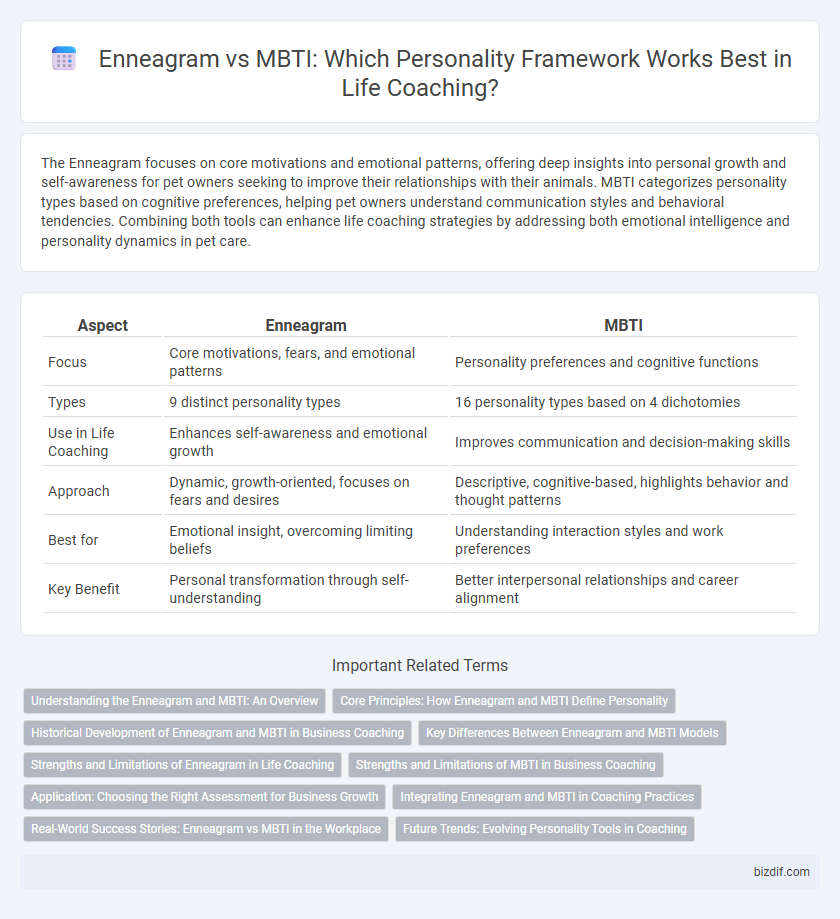The Enneagram focuses on core motivations and emotional patterns, offering deep insights into personal growth and self-awareness for pet owners seeking to improve their relationships with their animals. MBTI categorizes personality types based on cognitive preferences, helping pet owners understand communication styles and behavioral tendencies. Combining both tools can enhance life coaching strategies by addressing both emotional intelligence and personality dynamics in pet care.
Table of Comparison
| Aspect | Enneagram | MBTI |
|---|---|---|
| Focus | Core motivations, fears, and emotional patterns | Personality preferences and cognitive functions |
| Types | 9 distinct personality types | 16 personality types based on 4 dichotomies |
| Use in Life Coaching | Enhances self-awareness and emotional growth | Improves communication and decision-making skills |
| Approach | Dynamic, growth-oriented, focuses on fears and desires | Descriptive, cognitive-based, highlights behavior and thought patterns |
| Best for | Emotional insight, overcoming limiting beliefs | Understanding interaction styles and work preferences |
| Key Benefit | Personal transformation through self-understanding | Better interpersonal relationships and career alignment |
Understanding the Enneagram and MBTI: An Overview
The Enneagram and MBTI are prominent personality frameworks used in life coaching to enhance self-awareness and personal growth. The Enneagram identifies nine core personality types based on motivations, fears, and desires, providing deep emotional insights. MBTI categorizes individuals into 16 types using four dichotomies--Extraversion versus Introversion, Sensing versus Intuition, Thinking versus Feeling, and Judging versus Perceiving--focusing on cognitive preferences and decision-making styles.
Core Principles: How Enneagram and MBTI Define Personality
Enneagram defines personality through nine core types centered on motivations, fears, and emotional drives, emphasizing self-awareness and growth patterns. MBTI categorizes individuals into 16 types based on four dichotomies: Introversion/Extraversion, Sensing/Intuition, Thinking/Feeling, and Judging/Perceiving, focusing on cognitive preferences and decision-making. Both models serve as frameworks in life coaching for understanding behavior and tailoring personal development strategies.
Historical Development of Enneagram and MBTI in Business Coaching
The Enneagram's roots trace back to ancient spiritual traditions, gaining prominence in the 20th century through the work of Oscar Ichazo and Claudio Naranjo who integrated psychological insights, making it a valuable tool in business coaching for understanding deep personality motivations. The MBTI, developed by Katharine Cook Briggs and Isabel Briggs Myers during World War II, is grounded in Carl Jung's psychological types and has been widely adopted in organizational settings for team building and leadership development. Both systems have evolved into essential frameworks in life coaching, offering complementary approaches for enhancing self-awareness and interpersonal effectiveness in business environments.
Key Differences Between Enneagram and MBTI Models
The Enneagram model categorizes personality into nine interconnected types based on core fears and motivations, emphasizing emotional patterns and growth paths. MBTI divides personalities into 16 distinct types derived from four dichotomies--Introversion/Extraversion, Sensing/Intuition, Thinking/Feeling, and Judging/Perceiving--focusing on cognitive preferences and decision-making styles. Unlike MBTI's preference-based framework, the Enneagram provides insights into underlying emotional drives and dynamic personal development.
Strengths and Limitations of Enneagram in Life Coaching
The Enneagram offers a deep exploration of core motivations and emotional patterns, making it a powerful tool for self-awareness and personal growth in life coaching. Its strengths lie in uncovering subconscious drives and facilitating emotional intelligence, though its limitations include potential oversimplification of personality complexity and reliance on self-reporting that may introduce bias. Incorporating Enneagram insights alongside other models can enhance a holistic coaching approach by balancing emotional depth with behavioral analysis.
Strengths and Limitations of MBTI in Business Coaching
MBTI offers valuable insights into personality preferences, aiding business coaches in tailoring communication and leadership strategies for diverse teams. However, its limitation lies in oversimplification, as it categorizes individuals into fixed types, potentially neglecting situational behaviors and growth potential. MBTI should be integrated with other tools like the Enneagram to provide a more comprehensive understanding of client motivations and developmental paths.
Application: Choosing the Right Assessment for Business Growth
Selecting the appropriate personality assessment, such as the Enneagram or MBTI, depends on specific business growth objectives and team dynamics. The Enneagram offers deeper insights into core motivations and emotional drives, making it valuable for leadership development and conflict resolution. MBTI excels in identifying communication styles and cognitive preferences, aiding in team collaboration and role alignment for enhanced productivity.
Integrating Enneagram and MBTI in Coaching Practices
Integrating the Enneagram and MBTI in coaching practices enhances self-awareness by combining personality typing with deep motivational insights, enabling coaches to tailor strategies that address both behavioral patterns and emotional drives. Using the MBTI's cognitive functions alongside the Enneagram's core fears and desires facilitates personalized growth plans, improving clients' emotional intelligence and decision-making skills. This dual-framework approach supports transformative coaching outcomes by aligning personal development with authentic self-understanding.
Real-World Success Stories: Enneagram vs MBTI in the Workplace
Real-world success stories reveal that the Enneagram fosters deeper emotional intelligence and team cohesion, helping individuals navigate workplace conflicts with greater empathy. MBTI excels in identifying communication styles and aligning employees with roles that fit their cognitive preferences, boosting productivity and job satisfaction. Organizations integrating both systems report enhanced collaboration and tailored leadership development, driving measurable improvements in employee engagement and performance.
Future Trends: Evolving Personality Tools in Coaching
Future trends in life coaching highlight the integration of Enneagram and MBTI frameworks to create more personalized and dynamic personality assessments. Advanced AI-driven tools are enhancing the accuracy of these models, allowing coaches to tailor interventions based on real-time behavioral data. The evolving landscape emphasizes holistic approaches, combining cognitive, emotional, and motivational insights to support long-term personal development.
Enneagram vs MBTI Infographic

 bizdif.com
bizdif.com